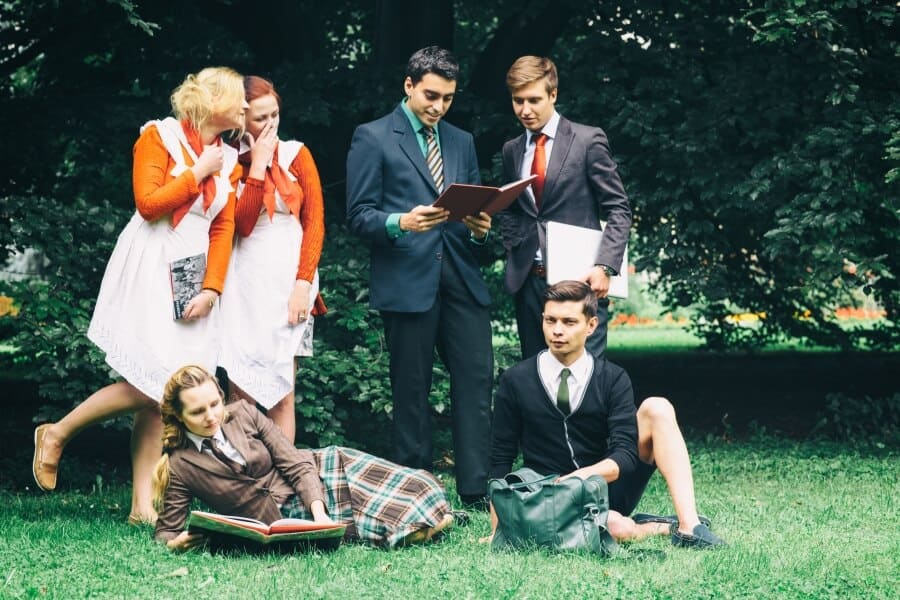The style of school uniform in a country can tell researchers a lot about the history and development of its society, the current state of its system of education, and the attitude of that society towards students as a class. Can all these firm collars, bows, coats of arms, ties and leather caps set teenagers on the right path?
England
The English style of uniform is the most famous and the most frequently copied. It emerged in the late Middle Ages with the opening of shelters for orphans and children from poor families. Their dress consisted of a dark blue jacket with coattails down to the ankle, a waistcoat, leather belt, and pants that were just below knee length. Later on, by the early 19th century, almost every school in England had introduced its own style of uniform, the concept of which remains unaltered to the present day – classic jackets and caps bearing the school’s coat of arms, ties, pants and socks, and during the winter time – a V-neck pullover.

The USSR
There were strict regulations regarding school uniforms in Tsarist Russia. However, after the revolution of 1917, the uniform was abolished because it represented “students’ bondage, it humiliated them”. A common school uniform was introduced in the USSR only after 1949, and the boys’ one was very reminiscent of military garments. The uniforms that most people associate with the USSR were introduced in the1980s. The girls’ uniforms consisted of brown dresses or sundresses, worn together with blouses. Boys wore blue pantsuits. Nowadays, there is a very reverent attitude towards the memory of the Soviet school uniform in the countries of the former USSR. The vast majority of girls who graduate from high schools attend graduation ceremonies dressed in the USSR fashion.

The United States of America
In the United States, each school is free to choose its own student dress code. There is no common uniform in the public schools, although some schools have introduced a dress code. Typically, dress codes ban students from wearing tops that reveal bellybuttons or low-rise pants. American pupils prefer to wear jeans, baggy pants with lots of pockets and T-shirts with clever prints. University students are trying to keep up the pace – the democratic style of clothing has become a symbol of American education

Germany
School uniforms are largely disfavored in Germany because they are associated with Hitler Youth outfits. Some schools have adopted common school clothing, and pupils can take part the design process, although it is hard to call what results a traditional school uniform.

India
When India was a British colony, Indian students were required to dress according to British rules. In modern India, the school uniform is still obligatory. Boys wear a light shirt and dark blue pants, while girls dress in white blouses and dark skirts. In some schools, saris that are alike in color and cut are school uniforms. Students often combine classic suits with traditional turbans, and it is acceptable at many schools for an Indian girl to come to school in a sari.

Japan
Wearing a school uniform is obligatory in the majority of Japanese middle and high schools. Most of the time, the boys’ one consists of a white shirt and dark jacket and is called “gakuran” and the girls’ one combines a white blouse, dark jacket and skirt with a distinctively exuberant tie – they call it “sailor fuku” or “sailor suite”. This uniform is adapted from the military dress of the Meiji period that was modeled on the European sailor garment. At the same time, a lot of schools are switching to dress codes similar to the dress codes of Western parochial schools. This includes a white shirt, tie, and sweater with the school’s coat of arms, with boys wearing pants and girls wearing plaid wool skirts. Stockings or socks are additional features of the Japanese schoolgirl’s wardrobe.

Support us!
All your donations will be used to pay the magazine’s journalists and to support the ongoing costs of maintaining the site.
Share this post
Interested in co-operating with us?
We are open to co-operation from writers and businesses alike. You can reach us on our email at [email protected]/[email protected] and we will get back to you as quick as we can.









